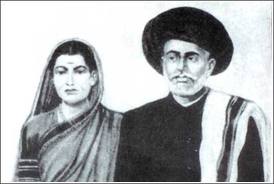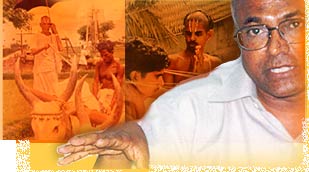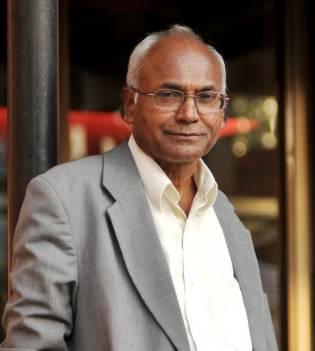Braj Ranjan Mani

Jotirao Phule, and his wife Savitribai, declared war on brahmanic-casteist culture and religion. This Maharashtrian couple presented the first major anti-caste ideology and led a mass activism against the ascriptive norms and values. Their distinct brand of socio-cultural radicalism was based on uniting all the oppressed, whom they would call stree-shudra-atishudra. (Literally, stree means women, shudra is productive servile caste at the bottom of the caste hierarchy, and atishudra means ‘those beyond the shudras’, earlier despised as outcastes, or untouchables. In contemporary language, shudras and ati-shudras are other backward classes and dalits, respectively. But the Phules included in their notion of the oppressed, other marginalised groups as well such as adivasis and Muslims.)
After a century of elitist trivialisation, Jotiba Phule is belatedly recognised as the father of Indian social revolution. An organic thinker and system builder, he founded the Satyashodhak Samaj (the Society of Truthseekers) in 1873, the first grassroots anti-caste organisation, and wrote many subversive books, including the famous Ghulamgiri (Slavery), a manifesto of sorts against the caste-brahmanic culture. His critique of the whole structure of hierarchy and oppression; his delineation of knowledge-power nexus; his deconstruction of brahmanic myth-history and attempts to replace it with an alternative reading of the past and present; his subversion of brahmanic religion and scriptures; his highly gendered view of women’s oppression and symbiosis between caste and patriarchy; his superb exposure of the emergent Hindubrahmanic nationalism as an extension of obscurantist, self-strengthening movement of the caste elites; and above all, his life-long campaigns for democratisation of education, have been highlighted in some scholarly and popular writings.
 Savitribai Phule (1831-97), struggled and suffered with her revolutionary husband in an equal measure, but remains obscured due to casteist and sexist negligence. Apart from her identity as Jotirao Phule’s wife, she is little known even in academia. Modern India’s first woman teacher, a radical exponent of mass and female education, a champion of women’s liberation, a pioneer of engaged poetry, a courageous mass leader who took on the forces of caste and patriarchy certainly had her independent identity and contribution. It is indeed a measure of the ruthlessness of elite-controlled knowledge-production that a figure as important as Savitribai Phule fails to find any mention in the history of modern India. Her life and struggle deserves to be appreciated by a wider spectrum, and made known to non-Marathi people as well.
Savitribai Phule (1831-97), struggled and suffered with her revolutionary husband in an equal measure, but remains obscured due to casteist and sexist negligence. Apart from her identity as Jotirao Phule’s wife, she is little known even in academia. Modern India’s first woman teacher, a radical exponent of mass and female education, a champion of women’s liberation, a pioneer of engaged poetry, a courageous mass leader who took on the forces of caste and patriarchy certainly had her independent identity and contribution. It is indeed a measure of the ruthlessness of elite-controlled knowledge-production that a figure as important as Savitribai Phule fails to find any mention in the history of modern India. Her life and struggle deserves to be appreciated by a wider spectrum, and made known to non-Marathi people as well.
Before underlining the significance of her struggle, let us touch upon the uniquely beautiful relationship that the Phule couple shared with each other. What made their match unparalleled was their total identification with each other, even in public life. She was still a teenager when she started involving herself in educational activities with her husband — playing an equally important role in founding and running schools for women and dalits — in the face of opposition from the orthodoxy whose power and authority she challenged. Savitri was only 18 and Jotirao was 22-years-old when they were maligned, ostracised, and finally turned out of their own home by Joti’s father who feared a high caste backlash for educating dalits and women, traditionally debarred under the brahmanic scheme from the right to education.
Just imagine, two young people in love taking on the home and the world not for their romance but for liberating the shackled and the crushed — with a majestic belief that every woman, every child and every man has a right, a divine right, a natural right, to get educated and remake their life. What is more remarkable, they kept alive this revolutionary spirit throughout their lives, setting a benchmark in social and political engagement that has few parallels anywhere.
To Savitribai and Jotirao, the idea of justice and fairness, of equality between man and woman seems to have been instinctive. Perhaps, it was more so in the case of Savitribai as she suffered more as a woman. She never needed convincing for the need of an inclusive and compassionate world. She had her convictions already from the start — straight and clear. Does that make her less revolutionary than the latter-day privileged radicals and feminists who have better mastered the dialectics and duality of the human world but struggle to enact their subversive intellectual constructs in their own lives, let alone animating other people’s lives?
Savitribai’s life and struggle is an excellent answer to the heart-cry of Marx, a revolutionary thinker: “Philosophers have only understood the world in various ways; the point, however, is to change it.” She did not understand the world in different ways, she understood it in one simple way — the necessity and possibility of making it more humane, more inclusive, more compassionate. What makes her important is that she lived up to this simple understanding in a magnificent way.
Savitribai’s role in the anti-caste and women’s struggle is unique. She emerges as the only woman leader among all social movements in nineteenth century India who linked patriarchy with caste. The nineteenth century is celebrated in history textbooks as the century of glorious socio-cultural regeneration led by an array of luminaries such as Rammohun Roy, Dayananda, and Vivekananda. What is not stated is the fact that the Indian Renaissance, confined to the upper echelons of society, was closely intertwined with the hegemonic neo-brahmanic Hinduism and the self-strengthening cultural nationalism. Savitribai Phule, on the other hand, was in the forefront of a socio-cultural struggle that challenged the tendency to focus only on higher social groups—brahman and allied castes. She encouraged a reversal of traditional subservient roles of women and depressed castes.
Apart from setting up the first ever school for women in India, Savitribai started a women’s association called Mahila Seva Mandal as early as 1852. The association worked for raising women’s consciousness about their human rights and other social issues. Being a woman, she easily recognised the double downtroddenness of most women as she saw the gender question in relation to caste and brahmanic patriarchy. She engaged herself at various levels to address women-specific problems. She campaigned against victimisation of widows. She advocated and encouraged widow remarriage. She canvassed against infanticide of’illegitimate’ children. She opened a home to rehabilitate such children. Her own home became a sanctuary for deserted women and orphaned children. She went on to organise a successful barbers’ strike against the prevailing practice of shaving of widows’ heads. She did all this taking grave personal risks. Many of these misogynistic practices have now receded in the background. But in her time, they tormented and destroyed countless women. Maligned, humiliated, and attacked for challenging the anti-women practices, Savitribai’s struggle encouraged and inspired a whole generation of outstanding campaigners for gender justice in Maharashtra — Dr Anandi Bai Gopal Joshi, Pandita Ramabai, Tarabai Shinde, Ramabai Ranade, and many others have been inspired by her efforts.
A unique spiritual vision sustained and animated Savitribai’s life and struggle. A deeply devout and compassionate person, she drew inspiration and strength from the benevolence of a higher power. Her belief in a higher power, however, led her to wage a war against discriminatory brahmanic gods. She despised caste-obsessed brahmanic religion and its rituals, but she was a great admirer of many moral and ennobling tenets of other religions. At the heart of her religiosity were compassion and a sacred morality that bound the individual with society. Like Jotiba Phule, she appreciated the power of culture and religion in the politics of transformation. Institutionalised religions, especially the caste-brahmanic Hinduism, have long been the target of social revolutionaries. But the tendency among many radical secularists to dismiss all religio-spiritual experiences as hoax is preposterous. Even Marx was not as dismissive of religion as he is generally made out to be. This becomes clear when we read him carefully.
As he writes in Contribution to Critique of Hegel’s Philosophy of Right, “Religious suffering is, at one and the same time, the expression of real suffering. Religion is the sigh of the oppressed creature, the heart of a heartless world, and the soul of soulless conditions. It is the opiate of the people.” In other words, religion is not unreal for the people. The important thing is, the use or abuse of religion. While most institutionalised religions have tended to align with the powers that be, thus going along the oppressive status quo, there have been other traditions where religio-spiritual greats have invoked God and religion to build an exploitation-free world. Kabir … would employ religious idioms to attack the oppressive political and religious authority. In (his) hands, religion became a weapon of the oppressed. On the other hand, Tulsidas, the author of Ram-Charita-Manas, did the opposite — he used religion in a most blatant manner to bolster caste and brahmanism. There is a world of difference between a Kabir and a Tulsidas. Unlike many atheist radicals, Savitribai and Jotiba Phule were sensitive to the power and hold of religion on people’s imagination. They saw real religion beyond caste and brahmanism, and strived to build an emancipatory religion.
At the centre of Savitribai Phule’s struggle was material and socio-spiritual liberation of the oppressed. It is a measure of her greatness that she lived up to this ideal more in her deeds than in her words. Anyone who is familiar with her life knows that she cared for others’ children like her own, and she was particularly fond of the weak and the abandoned. She died while she was nursing a plague- affected child — she got infected while serving the affected people. In her life and her death, she embodied the noble and the sublime. Not grandiloquent words and great ideals in abstract, but her day-to-day public life, her suffering with the suffering people makes her majestic.
~~~
[Courtesy: World Sikh News, April 9-15, 2008]










